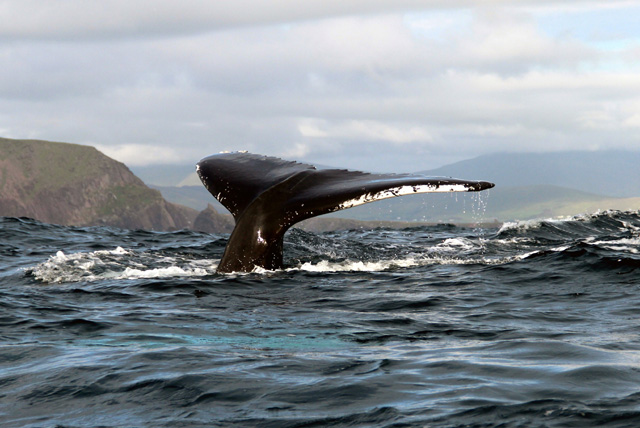Whale Watching In Ireland Irish Whale Watching West Kerry Ireland

Humpback Whale off Clogher Head 04.09.2016
Video
Best Place in Ireland to Watch Whales Dolphins 2017 Whale Watch Season
The best place(s) in Ireland to watch humpback whales; common, bottlenose and Risso's dolphins; Minke whales; basking shark; grey seals; puffins, gannets, storm petrels, Manx shearwaters and other sea birds, varies according to the seasons and the relative abundance of their food sources - mainly forage fish such as sprats (Sprattus sprattus); sand eels, which are actually small fish properly caled lance fish (Hyperoplus lanceolatus and Ammodytes tobianus - Greater sand eel and Lesser sand eel); whitebait - which is a general term for the immature fry of many other species including herring, sprat, sardines, mackerel, bass, plaice, eel etc; krill - which is a marine invertebrate shrimp-like pink plankton and various other copepod crustaceans like Calanus finmarchicus [ which scientists may use as an indicator species for studying climate change because of it's instinctive responses and physiological strategies for quickly adapting to rapidly changing environmental conditions] and other zooplanktonic microorganisms, which are the stuff of humpback dreams!
Geographically speaking the "league tables" change every year depending on the abundance or paucity of the above very important food sources in the food web. Before the food resources of sprat and herring were over-exploited by the pelagic fishing fleet off West Cork, it was by far and away the best place to see humpback and fin whales at the end of the Summer / Autumn period and then they went eastabout towards the Waterford coast during the Winter.
For 2016 this annually recurring cycle was reversed with approx. 100 different sightings of 26 different individual humpback whales recorded off the West Kerry coast where they appear to be feeding on the increasing schools of sand eels and various other whitebait, and then instead of going south to West Cork and eastabout to Waterford during the Winter, they more or less disappeared off our radar for a while before some individuals appeared off the mouth of the Shannon and West Clare in November / December, pursuing the last few remaining shoals of inshore spawning sprats before they were hoovered up by the mid- water commercial pair- trawling pelagic fleet.
Humpback Whales an Indicative Species of the Health of the Marine Food Web
Many people have been surprised at the abundance of humpback whales off the west and south west coasts of Ireland over the last few years and the IWDG has built up a data base of 76 individual humpback whales that visit Irish waters, some on a regular basis, as whales inherit site fidelity from their parents towards a feeding area, provided of course the resource is not over-exploited and depleted, when they are forced to change their feeding area and sources [ e.g. change from a diet of sprats (West Cork) to an area rich in a biomass of sand eels / whitebait (West Kerry)].
It is quite possible that if the forage fish resource is over-exploited humpback whales may disappear from Irish waters (again) and along with them many of our iconic breeding sea birds such as gannets, puffins, Manx shearwaters, guillemots, razorbills, kittiwakes who also depend on these forage fish resources.
Incredibly, in Ireland, marine fish and invertebrates "per se" are not protected under the Wildlife Act from which they are exempted, apart from salmon and bass, but under the Bonn Convention for the Protection of Migratory Species [UN] and the Birds and Habitats Directives [EU] the Irish State is obliged to protect these food resources and habitats and respect their importance in the marine ecosystem which is supposed to be the basis for proper fishery management. But please do not hold your breath too long for this to happen!
Marine Food Web changing in response to Climate Change
Some years ago while fishing for lobster I saw a Triggerfish (Balistes capriscus) for the first time- they use their lesser dorsal fin as a trigger to erect / release their defensive very sharp dorsal fin. We began to call them "Céard é" [ "What is it?" in Irish language] as that is what a friend of mine always said when they began to appear in the lobster pots. Of course the inevitable happened and a visitor on board one day asked us for the name of that strange looking fish. We immediately looked at each other and said " Céard é" and that is how the name stuck.
We were lucky enough that when we started our ecotourism business some years ago it coincided with the increasing arrival of humpback whales to the West Kerry coast and this year we had irregular sightings of humpback whales off the West Kerry coast all summer long from April 10th to October 11th. Towards the end of our season in September / October we saw albacore tuna and Bluefin tuna chasing prey and breaking the surface just a couple of miles offshore. There is also evidence that Sailfish ( Istiophorus albicans), the fastest swimming fish in the ocean; sardines and anchovies are becoming more plentiful off our south coast.
It is now time for properly funded scientific research to be done on the changing patterns of marine wildlife distribution in the Irish marine ecosystem, which is unprotected under the Irish Wildlife Act, all the way from krill, sand eels and sprat to humpback whales and Bluefin tuna so that the changing resource can be used in a properly managed ecosystem-friendly way to the benefit of all - both to local Sustainable Fisheries and artisan food production e.g. smoked sprat, and equally to the benefit of local indigenous coastal communities who are equal stakeholders in the ever changing and dynamic blue economy.















